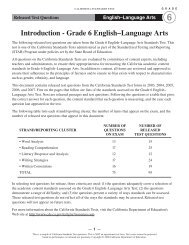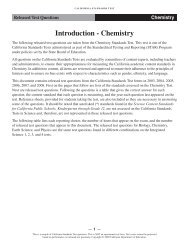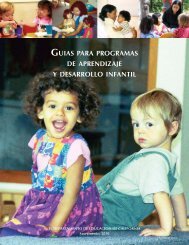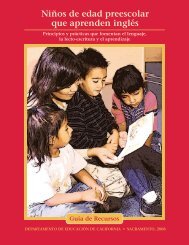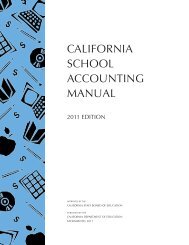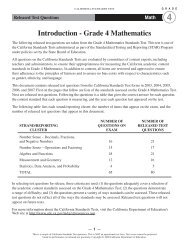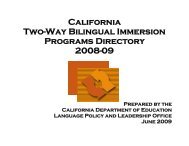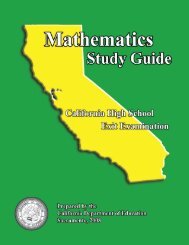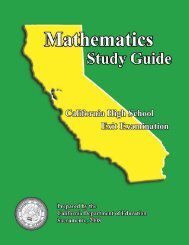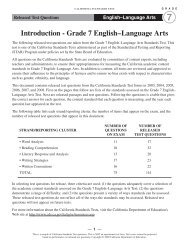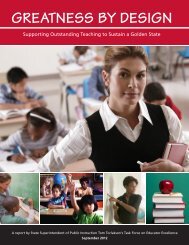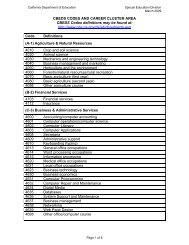Grade 2 - California Department of Education
Grade 2 - California Department of Education
Grade 2 - California Department of Education
Create successful ePaper yourself
Turn your PDF publications into a flip-book with our unique Google optimized e-Paper software.
State Board <strong>of</strong> <strong>Education</strong>-Adopted <strong>Grade</strong> Two Page 33 <strong>of</strong> 45<br />
524<br />
525<br />
526<br />
527<br />
528<br />
529<br />
530<br />
531<br />
532<br />
533<br />
534<br />
535<br />
536<br />
Second grade students understand that there are two cycles <strong>of</strong> twelve hours in a<br />
day—a.m. and p.m. A daily journal can help students make real-world<br />
connections and understand the difference between these two cycles.<br />
[Note; Sidebar]<br />
Focus, Coherence, and Rigor:<br />
Students understanding and use <strong>of</strong> skip counting by 5s and 10s (2.NBT.2▲) can also support<br />
telling and writing time to the nearest five minutes (2.MD. ▲7). Students notice the pattern <strong>of</strong><br />
numbers and apply this understanding to time (MP.7)<br />
Students solve word problems involving dollars or cents (2.MD.8). Students<br />
identify, count, recognize, and use coins and bills in and out <strong>of</strong> context. They<br />
should have opportunities to make equivalent amounts using both coins and bills.<br />
“Dollar bills” should include denominations up to one hundred ($1, $5, $10, $20,<br />
$100). Note that students in second grade do not express money amounts using<br />
decimal points.<br />
537<br />
538<br />
539<br />
540<br />
541<br />
542<br />
543<br />
544<br />
545<br />
Just as students learn that a number (38) can be represented different ways (3<br />
tens and 8 ones; 2 tens and 18 ones) and still remain the same amount (38),<br />
students can apply this understanding to money. For example, 25 cents could be<br />
represented as a quarter, two dimes and a nickel, or 25 pennies, all <strong>of</strong> which<br />
have the same value. Building the concept <strong>of</strong> equivalent worth takes time and<br />
students will need numerous opportunities to create and count different sets <strong>of</strong><br />
coins and to recognize the “purchase power” <strong>of</strong> coins (a nickel can buy the same<br />
things as 5 pennies).<br />
546<br />
547<br />
548<br />
549<br />
550<br />
551<br />
As teachers provide students with opportunities to explore coin values (25 cents),<br />
actual coins (2 dimes, 1 nickel), and drawings <strong>of</strong> circles that have values<br />
indicated, students gradually learn to mentally give each coin in a set a value,<br />
place a random set <strong>of</strong> coins in order, use mental math, add on to find differences,<br />
and skip count to determine the total amount.<br />
The Mathematics Framework was adopted by the <strong>California</strong> State Board <strong>of</strong> <strong>Education</strong> on<br />
November 6, 2013. The Mathematics Framework has not been edited for publication.



